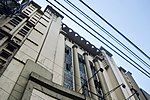Black Nazarene

The Black Nazarene (Spanish: El Nazareno Negro; Filipino: Poóng Itím na Nazareno) is a life-sized image of a dark, genuflecting image of Jesus Christ carrying the True Cross enshrined in Minor Basilica of the Black Nazarene in Quiapo, Manila, Philippines.The image was reputedly carved by an unknown Mexican artist in the 16th century and then brought to the Philippines in 1606. It depicts Jesus en route to his crucifixion. Pope Innocent X granted recognition to the lay Confraternity of the namesake image in 1650 for religious devotion. It was housed in various churches near Manila, then permanently stationed in Quiapo Church in 1787 where it remains today.Pope John Paul II issued a Pontifical decree Qui Loco Petri which raised the shrine to the status of Minor Basilica on 11 December 1988. The decree was signed and notarized by the Vatican Secretary of State, Cardinal Agostino Casaroli. Pious believers claim that physically touching the image can bring miracles and cure diseases. The original image or its replica is given a religious procession three times a year: January 9 — the official Feast of the Black Nazarene commemorating the translation of the image from Intramuros. Good Friday — it’s liturgical feast, commemorating the culmination of the Passion of Jesus. December 31 — the eve of New Year commencing its novena.
Excerpt from the Wikipedia article Black Nazarene (License: CC BY-SA 3.0, Authors, Images).Black Nazarene
Evangelista Street, Manila Quiapo (Third District)
Geographical coordinates (GPS) Address Nearby Places Show on map
Geographical coordinates (GPS)
| Latitude | Longitude |
|---|---|
| N 14.598888888889 ° | E 120.98361111111 ° |
Address
Jaime Cardinal Sin Building
Evangelista Street
1001 Manila, Quiapo (Third District)
Philippines
Open on Google Maps








